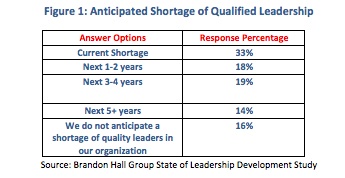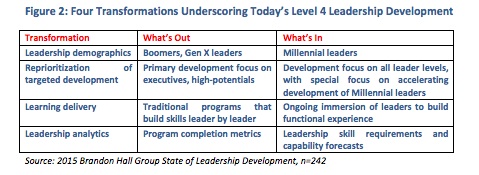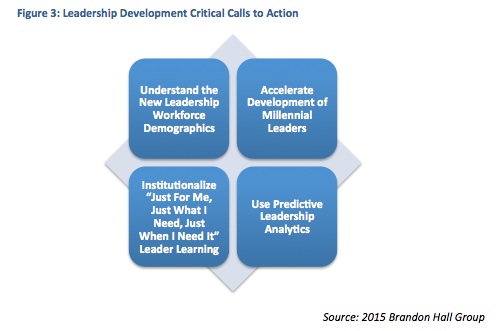
Brandon Hall Group research shows that top-quality talent is immensely challenging to source externally; 55 percent of organizations told us they were struggling with a talent shortage, and 64 percent indicated their greatest talent challenge was attracting talent.
For this reason, organizations are focused on growing internal talent to meet business needs, and, therefore, leadership development is a clear and continuing talent priority year over year. Nonetheless, 36 percent of organizations say their leadership development practices are still below average or poor, according to our 2015 State of Leadership Development Study of more than 500 organizations from 34 countries and 31 industries.
Half of organizations said their leaders are not skilled to effectively lead their organizations today, and a startling 71 percent said their leaders are not ready to lead their organizations into the future. Finally, 25 percent of organizations said they had a ready and willing successor identified for 1 out of 10 critical leader positions.

Organizations are not only struggling with shortages of talented leaders. Today’s influx of Millennial leaders is creating a second and pressing challenge for organizations everywhere. The U.S. Bureau of Labor Statistics indicates that Millennials already form 34 percent of the U.S. workforce; by 2020, the number will be 46 percent of the global workforce. Currently, 15 percent of Millennials are already in management roles, and more than half (53 percent) of Millennials aspire to become the leader or most senior executive within their current, or another, organization.
With their aggressive goals for movement and promotion come urgent needs and requirements for organizations to accelerate leadership development for Millennials. As digital natives, they expect instant access to information and knowledge, continuous learning and development experiences, constant attention, rapid progression, and perpetual feedback. The organizations with the most success in developing Millennial leaders will not be constrained by “how things used to be done.” The Millennials already have started shaping a new world of work and leadership development and will continue to do so for years to come. Irrespective of the long-term aims and ambitions of any organization, the ability to effectively develop Millennial leaders —starting now—will be a vital step to achieving it.
To gain insights about the details and influences of today’s workplace and workforce challenges on leadership development, we analyzed our survey results and interviewed several CEOs, Chief Talent Officers, and other senior business leaders, as well as HR and Talent leaders. Four contemporary transformations underscore an organization’s ability to implement Level 4 leadership development, which we define as optimized leadership capacity that can transform and sustain business success.

Our LD research also validated two long-standing and standard practices influencing organizations’ ability to transform leadership development:
- Definition of leadership requirements before designing leadership development solutions
- Clarity about practices that yield the most effective leadership development
While core leadership development training programs are not necessarily being eliminated, by themselves, they are just not enough to create leadership development that makes a business difference. The ongoing transformation of our workforces and workplaces are fervently influencing today’s leadership development decisions and actions.
Understanding the Leadership Development Critical Calls to Action
Our research revealed at least four critical calls to action to improve the business impact of leadership development.

1. Understand the New Leadership Workforce Demographics. Our workforce has changed and more change is around the corner. With 10,000 or more Baby Boomers retiring each day, only 16 percent of today’s workforces are Gen Xers. Therefore, the majority of our workforces today are Millennials (Gen Yers), and by 2020, data shows that nearly half of all U.S. workers will be in this group.
Two-thirds of Millennials admit they are disenchanted at work and already looking for a new job. It costs employers, on average, $20,000 to replace every Millennial who leaves. Of those who stay, an overwhelming 91 percent say they plan to stay in their current jobs fewer than three years. The challenge is here—and in full blaze: The emerging workforce has new expectations about organizational investment and the approach to their learning, leader development, and career moves.
2. Accelerate Development of Millennial Leaders. Some 84 percent of organizations anticipate a shortfall in the minimum number of qualified leaders over the next five years. One-quarter of organizations said less than 10 percent of all critical leader positions have one ready and willing successor. Over the next one to two years, organizations say the top priorities for leadership development are closing leader skill gaps (58 percent) and closing critical leader gaps across all leader levels (43 percent).
With Millennials occupying 15 percent of management positions today and that number expected to more than double in fewer than 10 years—combined with the impending retirement of Baby Boomers—employers will continue to face leadership gaps, and big ones if imminent action is not taken. Fast-tracking Millennial leader development—starting now—is the burning need in organizations everywhere to close both current and anticipated leader opportunity and performance gaps.
3. Institutionalize “Just For Me, Just What I Need, Just When I Need It” Leader Learning. Today’s leaders—at all levels—and particularly Millennial leaders, demand a lifelong learning experience supported by on-demand and easily searchable micro-content shaped and prescribed for their specific learning and knowledge needs.
The true focus of development, regardless of generation or leader level, should be on encouraging the learners to question and explore, to experience and innovate—not on forcing them to consume a canon of pre-designed training modules comprising a fixed curriculum delivered as a one-way transfer bound by the classroom’s time and place.
However, 56 percent of organizations still depend largely on formal classroom training. The time has come to rethink and transform your leader development delivery strategy. While Brandon Hall Group’s research data points to ongoing effectiveness of the classroom experience in leadership development, it alone is no longer enough—for any organization anywhere.
4. Use Predictive Leadership Analytics. Some 89 percent of organizations said using predictive analytics to anticipate “what if” leadership requirements is important or very important, yet only 7 percent of organizations have fully adopted predictive capability. By and large, organizations are not applying predictive analytics to their organization’s biggest asset—its leaders.
Leadership analytics helps organizations with real-time, statistically sound, real-time decision-making regarding “what if” leadership scenarios and forward-looking leadership requirements. Leadership analytics helps organizations plan for, and mitigate, leadership gaps—opportunity and performance—before they disrupt business performance. Level 4 organizations invest in predictive leadership analytics because they not only enable the measurement of the business impact of leadership and leadership development decisions, but also help optimize and prescribe future leadership development investments.
Laci Loew is VP and principal analyst for Talent Management and Leadership Development at Brandon Hall Group, a human capital management (HCM) research and advisory services firm that provides insights around key performance areas, including Learning and Development, Talent Management, Leadership Development, Talent Acquisition, and Workforce Management.




